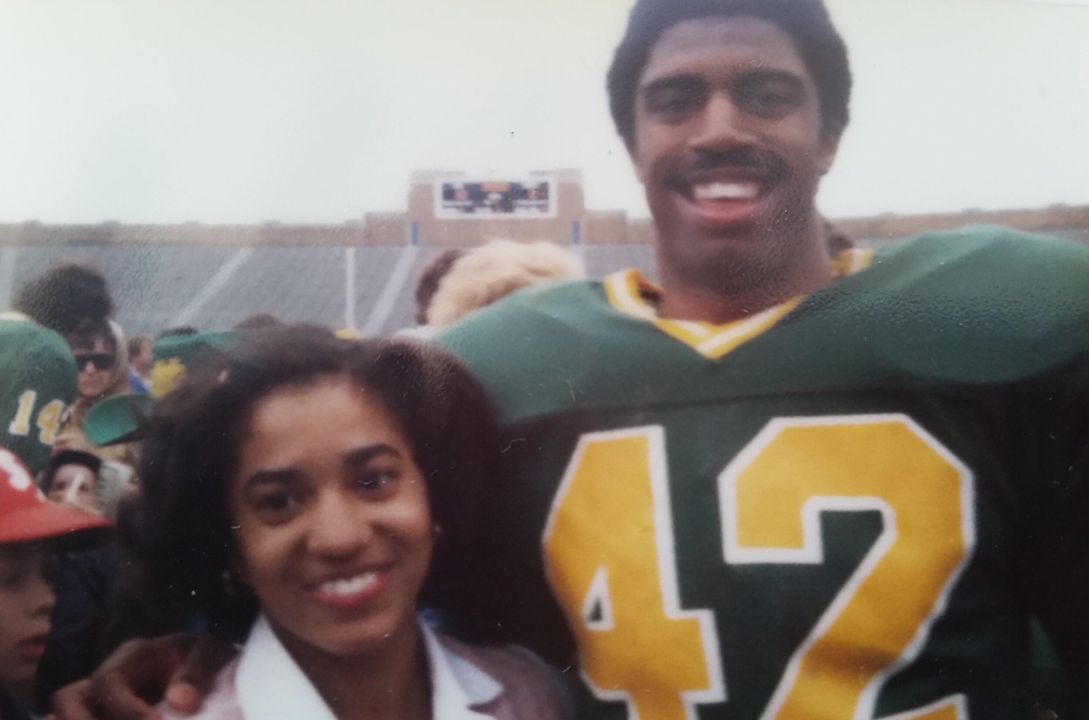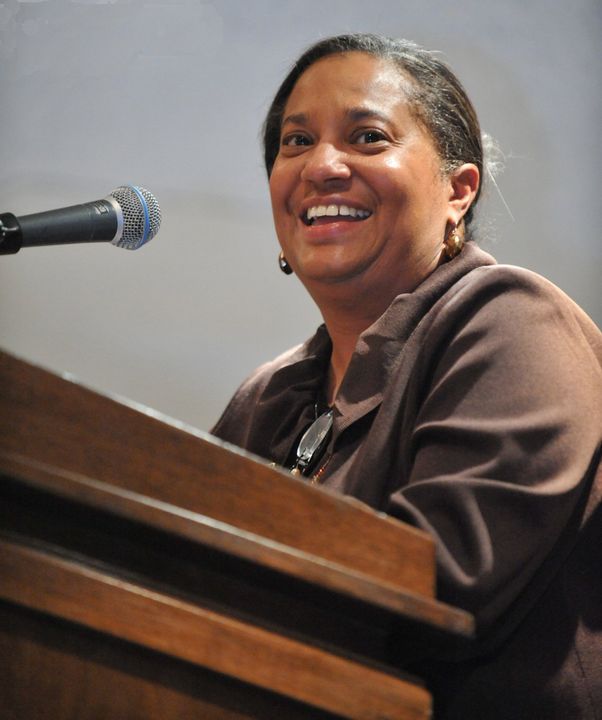Phyllis Washington Stone: Keep the Faith
By Phyllis Washington Stone '80Phyllis Washington Stone graduated from the University of Notre Dame in 1980 with her degree in American Studies. The Chicago native was elected captain of the all-white cheer team for the 1978-79 season and would later serve her alma mater as a Monogram Club board member from 1990-93. Stone is now a corporate executive coach and leadership consultant. She and her husband, fellow Notre Dame alumnus Jim, live in New Jersey.
This installment of Signed, the Irish is part of a yearlong celebration in honor of Thompson’s legacy and the extraordinary contributions by our Black student-athletes.
Joya DeFoor made sure she was my biggest cheerleader as I tried out to become one just like her.
As the only Black cheerleader on the squad and on her way out the door after graduation, she was very supportive and came to the tryouts to support me.
But she saw the judges mark zeros for me before I would even do anything, could even perform, and so when I didn’t make the squad, we were both upset.
Later, we took to the steps of the Administration Building to protest about a number of things — it had to do with the culture of the campus and how it wasn’t very inclusive of us as Black students.
As a result, we were invited to Fr. Hesburgh’s office to discuss the issues facing our campus.
As we were getting ready to leave, my Big Brother (no kin), who was senior at the time, turned to Fr. Hesburgh and said, “One more thing. This young lady was trying out for cheer, and they gave her zeroes before she was even able to perform.”
Fr. Hesburgh was appalled.
“We have Black football players,” he said. “I see no reason why we shouldn’t have Black cheerleaders.”
And so, he appointed me to the Notre Dame cheer team.

I was all set to go to the Illinois Institute of Technology to study engineering when my mother suggested I look at the school 90 miles down the road, Notre Dame.
“What is that? And where is it?”
When I got in and visited, I was still on the fence, but she encouraged me, saying to just try it for a year.
There were only nine Black women in my class that year. It was intimidating, but most of us were housed in Lewis Hall and bonded right away — I still remain close with most of them.
There wasn’t a sizable Black community at Notre Dame, but it was a supportive one. We had the Black Cultural Arts Center; we had a support structure.
Many of us were from nearby cities — Gary, Cincinnati, Chicago — so those in our group who were from places further away would come home with us during the breaks. Our families would come to visit campus a lot — so we also had a lot of Black extended family around us. Also, what few Black faculty and staff there were who lived in the South Bend community welcomes us into their homes, too.
I had grown up as a cheerleader and amateur dancer doing Afro-Cuban, jazz, and modern dance. I really wanted to continue dancing even though I wasn’t going to be a professional dancer.
The second year I tried out, just one year after getting all zeros from the judges, I had my feet under me and was so confident. I completed a stunning routine and everyone was cheering so loudly, which made me feel really good.
I got the highest score of anyone competing and I earned the captaincy of my all-white team, becoming the first Black captain in Notre Dame Cheer history.
Leading the squad I thought was relatively easy from a skills standpoint, but it said to me that my peers accepted me and it meant so, so much.
Cheering gave me some of the most fun experiences at Notre Dame. In high school, I never had the opportunity to cheer football, so coming here and watching the Irish win a national championship in 1977 was incredible.
My future husband, Jim, was a running back on that national championship team and watching them play gave me new insight into folks that have to use a lot of muscle to pull together to get things done. They had the attitude and belief and faith and trust in each other.
Then there were the moments off the field — one of my teammates, Loretta, was from Murfreesboro, Tennessee. When we played in Memphis, we went to her house, and for the first time, I tasted cheese grits… I’ve loved them ever since!
I remained involved with the university after I graduated and served as an officer of the Monogram Club. I was young and it was one of the first organizations that kind of opened my eyes to what being a Notre Dame alum out in the world meant.
The Monogram Club brought alums together from all over the country. There’s a long, long legacy of athletics at Notre Dame, and so there was always strong, solid involvement. I remember it being a taste of what my life was going to be like in terms of this Notre Dame family you belong to now after you graduated.
I’m happy and grateful for every step in the right direction the university makes to make people feel inclusive. I think one of the benefits of being involved in athletics is that you feel included… even if you don’t feel included in other ways on campus.
Notre Dame has some work to do, as we all do, in terms of inclusivity. But ND does a lot of things right too. In terms of investing in the future of people and Notre Dame students, I just hope that others will want to give back to the University. I pray that people get to the point where they feel that Notre Dame has done so much for them that they want to pay it forward to the students that are coming behind them.
That’s how we sustain the legacy of who it is we are.
I hope that tomorrow’s student-athletes will just know that — despite obstacles — they’re in an environment and part of teams and surrounded by people who really value you. I think that’s always been the case.
Keep the faith.







